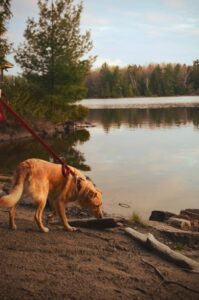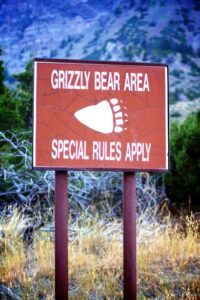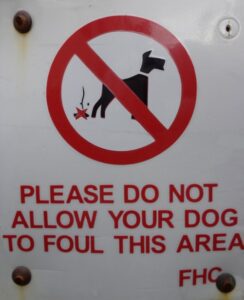 This is a re-post from last year. However the information is handy and relevant each year around the time when we pack up for camping vacations. Have fun and be safe!
This is a re-post from last year. However the information is handy and relevant each year around the time when we pack up for camping vacations. Have fun and be safe!
by Cheryl Smith, DVM
If you are an avid camper, it would seem natural that you would want to take your dog with you. Both you and your dog are likely to enjoy the great outdoors more with each other.
Most dogs just need a food supply and fresh water; there is no special equipment really needed that you wouldn’t already have. Materials for first aid would be similar.
Like camping with children, extra planning and precautions are needed. To ensure there will be no problems with laws and regulations, planning and researching acceptable locations to camp is needed. In general, access for dogs to national parks is very restricted (and then on a leash no longer than 6 feet); at Pictured Rocks, for example, on leash pets are allowed at the drive-in campgrounds but not on the hiking trails and most of the rest of the park, while Sleeping Bear Dunes allows on leash dogs throughout much of the park, excluding them in areas where they might disturb wildlife.
 Many state parks in Michigan and across the country are more accommodating than national parks. Several websites, such as Pet Friendly Travel (covering National and State Parks) and PetVR.com, identify dog-friendly parks and areas you are allowed to be with dogs. Likewise, being familiar with and willing to adhere to any special rules are needed to ensure parks and wildlife areas that accept dogs will continue to do so. (See also the National Park Service site and Michigan’s DNR site for more information.)
Many state parks in Michigan and across the country are more accommodating than national parks. Several websites, such as Pet Friendly Travel (covering National and State Parks) and PetVR.com, identify dog-friendly parks and areas you are allowed to be with dogs. Likewise, being familiar with and willing to adhere to any special rules are needed to ensure parks and wildlife areas that accept dogs will continue to do so. (See also the National Park Service site and Michigan’s DNR site for more information.)
Well behaved pet dogs still need extra training and impulse control. Wildlife encounters with potentially dangerous species become more likely the more remote areas you travel. Poisonous snakes are problematic in yards and neighborhoods where they indigenous; if your dog does not have experience with snakes, there is a real danger. Knowing how to avoid poisonous snakes would be important depending on where you are hiking and camping.
 Larger wildlife causing nuisance problems at campsites (raccoon, bear, opossum, skunk) can be complicated by a dog eager to engage with the presence of the wildlife. The dog’s early detection and barking may prevent a problem, or could really complicate the situation. No one likes dealing with skunk smell and there is potential for serious eye problems if sprayed there; a raccoon can inflict serious harm to dogs and then of course there is always a real concern about rabies any time there is contact. Engaging a bear as a single dog could easily prove deadly for the dog.
Larger wildlife causing nuisance problems at campsites (raccoon, bear, opossum, skunk) can be complicated by a dog eager to engage with the presence of the wildlife. The dog’s early detection and barking may prevent a problem, or could really complicate the situation. No one likes dealing with skunk smell and there is potential for serious eye problems if sprayed there; a raccoon can inflict serious harm to dogs and then of course there is always a real concern about rabies any time there is contact. Engaging a bear as a single dog could easily prove deadly for the dog.
Encountering porcupines can also prove to be a very painful and complicated life event for your dog. It is unlikely to occur when you are walking on established trails during the day, so dogs on leash and contained at the campsite at night are unlikely to get into trouble.
Being in remote areas also makes it difficult to get prompt medical attention.
 In camp, a dog may be an asset to early alarm and a deterrent to wildlife. If you keep your dog on leash and it doesn’t leave your campsite, its risk is similar to your own.
In camp, a dog may be an asset to early alarm and a deterrent to wildlife. If you keep your dog on leash and it doesn’t leave your campsite, its risk is similar to your own.
Responsible camping and hiking also includes leaving behind no waste. If you are camping where you have to bury or carry human waste, the same is likely expected if you take your dog.
If you are careful, plan ahead, and follow the rules, you can certainly share your camping and hiking adventures with your dog.
Recent Posts
About Us
Ann Arbor Animal Hospital is a locally-owned animal hospital operating for over 90 years in Ann Arbor, MI.
